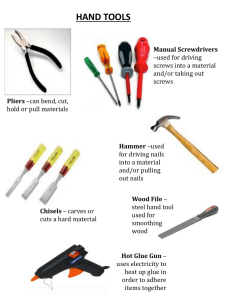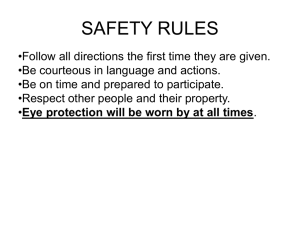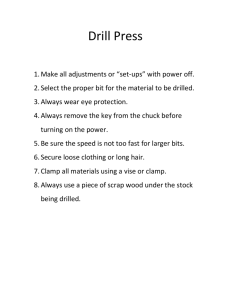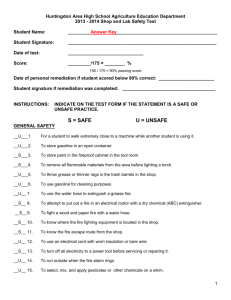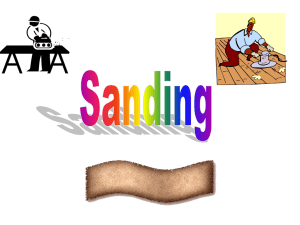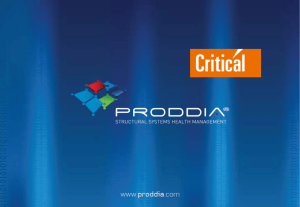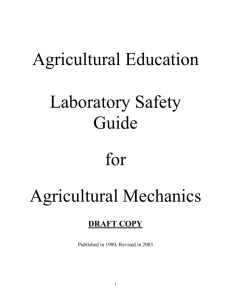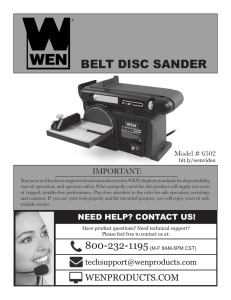Portable Power Tools - Biosystems and Agricultural Engineering
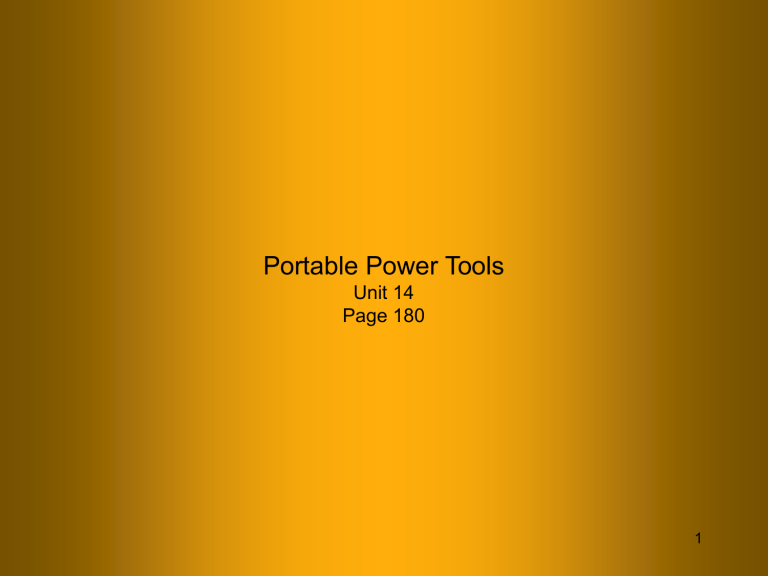
Portable Power Tools
Unit 14
Page 180
1
Introduction
• Portable Power Tool: A tool that can be held in the operators hands, but is not hand powered.
• Four common sources of power.
Battery
Electricity
Pneumatic
There are advantages and disadvantages for each type of power source.
Engine
2
1. Electrical Power
• Very popular
• Usually use 120 V, 1ø power
Disadvantages
– Must stay connected to power cord.
– Hazards of electricity
Advantages
– Unlimited power
– Many different types of tools.
Extension cord must be proper size and in good condition.
3
2. Pneumatic
Becoming more popular where compressed air is available.
Advantages
– Smaller dimensions for torque produced
– Torque easily adjusted
(changing pressure)
– Popular in hazardous environments
Disadvantages
• Air must be clean and dry.
• A blast of high pressure air can embed objects in the skin or eyes.
• Air hose more difficult to manage than electric cord.
All common tools can be air driven.
– Drills
– Ratchet drives
– Sanders
4
3. Battery
New technology in batteries has made battery powered tools the first choice for most professionals.
Advantages
– Portability
– Sealed unit
– No electrical circuit hazards.
– Can be used with a wider variety of tools when compared to pneumatic.
Disadvantages
– May be less torque
– Must have a charged battery to use.
– Batteries can have a short useable life and are expensive to replace.
5
4. Engine
Popularity is gaining with the resent invention of lighter weigh engines.
The elimination of 2-cycle engines will require a redesign.
Advantages
Portability
No air hose
No extension cords
No battery
Disadvantages
– Must be used in open environment.
– Disadvantage of engine maintenance.
– Safety concerns of gas engines.
– Usually only large sizes.
6
Portable Power Tool Safety
• Use GFCI protected circuit.
• Use three-wire electrical source if tool housing is metal or partially metal and not double insulated.
• Insure blades, bits, and other cutting devices are clean and sharp
• Support work carefully
• Keep all tools clean and free of dirt.
• Keep tool vent holes clean.
• Wear appropriate personal protection
• Avoid or use extra care when working in wet areas
• Do not force tools to work.
• Hold power tool firmly and insure your have control at all times.
• If the condition of the tool is in doubt, do not use.
• Announce to co-workers before starting a tool.
• Lay tool down correctly
• Take any faulty tools out of use and insure they are fixed before returning.
7
Nail Guns
• Popular because they are fast and efficient.
– Produce enough force to drive 2 - 3 inch nail into dense wood.
– Accelerate nail to 1,000 feet per second.
• Four types
– Brad
– Framing
– Finishing
– Staple
• Power
– Pneumatic
– Electric
– Fuel cell
• Fasteners
– 1/4 inch brad and staples up to 4 inch nails.
8
Portable Drills
• Size
– Size based on capacity of chuck
– Wattage difference within chuck size
– Common sizes are 1/4, 3/8, 1/2 &
3/4 inch
• Construction
– Case will be metal, non-metallic or a combination.
– Wide variety
• Options
– Variable speed
– Reversing
– Extra handle
– Hammer action
– Torque clutch
– Depth stop
– Drill press attachment
– Keyless chuck
– Screw chuck
9
Portable Drill-cont.
• Use many different types of bits.,
• Drill holes and slots
• Use to drive screws
• Sanding disc and wire wheels can be used.
– Must be careful to not exceed the duty cycle
Always center punch location of hole.
Drill pilot hole before using a large drill bit.
10
Portable Drill Safety
• Inspect bit before using
• Tight chuck using more that one hole
• Center punch metal before starting to drill
• Hold material securely
• Do not exceed rpm of bit
• Use even pressure
• Ease off pressure when drill starts to break through
• Don’t bind the drill bit
• Stand in a balanced position
• Remove the drill from the chuck when finished
• Store portable drill and bits in case or designated storage rack.
11
• Three common types
– Belt
– Disc
– Pad
Sander
12
Sander-cont.
• Portable power sanders to the same job as hand sanding--just faster.
• Normally sand with the grain
• Exceptions
– Uneven boards
– Rough surface
– Removing difficult finishes
• Different grit paper available
– Coarse grit = rapid sanding, rough surface
– Fine grit = slow sanding, smooth surface
13
Belt Sander
• Very versatile
Popular for rough sanding because of aggressive action with coarse belts.
Can produce smooth finish with fine belt.
• Some belts are not bidirectional.
• Dust collection system highly recommenced.
14
Belt Sander Safety
• Wear appropriate PPE
• Check cords and switches
• Install appropriate belt for the desired cutting action and finish
• Lay sander on side when not in use
• Empty dust bag frequently
• Always start sander above the surface
• Use two hands at all times
• Keep machine in motion
• Lift off material while still running
• Never sand on the drums
15
Disc Sander
• Machine can use sanding disc, grinding wheel and wire brush interchangeably.
• Must follow manufacturer's recommendation for use.
Motor Housing
Tool Rest
Sanding
Wheel
Switch Lock
Sanding
Disc
Power Cord
Handle
Vents
Handle
Switch
Guard
• Several tools with this right angle design look the same.
• Some are sanders, some are sanders/grinders and some are grinders.
• Big difference in construction
• Grinders are much heavier construction.
16
Disc Sander Safety
• Select the sanding wheel appropriate for the material being sanded.
– Aluminum oxide = wood or metal
– Flint paper = wood only
• Use the appropriate guard
• Wear appropriate PPE.
• Grip machine firmly in both hands before starting
• Do not force the machine to work
• Lay the machine on the tool rest, not the disc.
• Be aware of, and plan for the direction of material being discharged by the wheel.
• Hold small pieces in a vise.
17
Disc Grinder Safety
• Wear face shield plus safety glasses.
• Check grinding wheel for cracks before using
• Only use wheel designed for that machine.
• Never use grinding wheel that is less than 1/2 original diameter.
• Secure small pieces in a vise
• Do grind near combustibles
• Hold the machine with both hands at all times.
• Always be aware of were the discharged sparks and grit is going.
18
Motor Housing
Handle
Pad (Finishing) Sander
Switch Lock Handle
Power
Cord
Paper
Clamp
Sand
Paper
• Multiple pad movements possible.
– Reciprocating
– Circular
– Orbital
– Random
• Slower cutting
Switch
Paper
Clamp
Pad
19
Pad Sander Safety
• Use appropriate PPE.
• Use correct size of paper.
• Disconnect power when changing paper.
• Only use light pressure when sanding
20
Portable Saws
• Portable saws can be divided into three categories.
– Sabre
– Reciprocating
– Circular
21
Switch
Blade
Retention
Screw
Toe
Blade
Sabre Saws
Handle
Power
Cord
Motor
Housing
Base Tilt
Lock
Base
• A compact saw that is very useful for cutting curves.
• Designed for wood, but will cut thin metal.
• Blade uses reciprocating motion.
• Can be used for blind cuts.
• Base may tilt for cutting bevels.
22
Sabre Saw Safety
• Wear appropriate PPE
• Select correct blade for job.
– Width of blade determines minimum radius
• Secure material being cut
• Let saw determine feed rate.
• Must maintain downward pressure on the saw when cutting.
23
Reciprocating Saw
• Usually heavier duty that the sabre saw.
• Longer stroke on the blade.
• Many different types of blades.
• Designed for wood and metal.
Shoe
Blade
Motor Housing
Blade
Retention
Screw
• Does not cut as precise as sabre saw.
• May be multiple speed.
• Can be used to make a blind cut.
• Very popular for demolition work.
Switch
Switch
Lock
Handle
Cord
Vents
24
Reciprocating Saw Safety
• Wear appropriate PPE.
• Select the correct blade for the job.
• Select the correct speed.
• Be careful not to bind, pinch or crowd the blade.
• Hold the shoe against the work at all times.
• Do not wear loose fitting clothing.
25
Circular Saw
• Most popular saw for carpentry work.
• Different size and types of blades are available.
• Can be used for wood and metal.
• Available in direct mount, right and left hand and worm drive.
26
Circular Saw Safety
• Wear appropriate PPE.
• Use face shield + safety glasses
• Use blade appropriate for work.
• Support work correctly.
• Disconnect the power when adjusting the saw.
• Adjust blade for depth so that only 1/4 inch or the depth of one tooth extends through the work.
• Hold saw in both hands.
• Start the saw before contacting work.
• If the saw stalls, back out of kerf.
• Watch the line ahead of the saw.
• Near the end of the cut reduce the pressure.
• For ripping use the ripping guide attachment or clamp a straight edge to the work.
27
Circular Saw Capacity
• Capacity of portable circular saws at 45 degree bevel and straight.
BLADE DIAMETER CAPACITY 45 o
4 1/2
6 1/2
6 3/4
7 1/4
7 1/2
8 1/4
10 1/4
12
1 1/16
1 5/8
1 3/4
1 7/8
2 1/16
2 1/4
2 3/4
3 5/16
CAPACITY 90 o
1 5/16
2 1/16
2 7/32
2 3/8
2 17/32
2 15/16
3 5/8
4 3/8
28
Router
• Routers are used for specialized jobs such as ornamental shapes, rabbets, dadoes, hinges, etc.
• Router bits turn at high speeds.
• May have several attachments.
• Must use guide to complete straight cuts.
• May be mounted on a table.
Cord
Switch
Depth of Cut
Adjustment
Depth of cut
Scale
Handle
Collet
Base
29
Router Safety
• Wear appropriate PPE.
• Secure work.
• Insure router is unplugged before installing bit or setting depth adjustment.
• Always inspect bit for condition and sharpness.
• Install the appropriate bit.
• Insure bit shank is fully inserted into collet.
• Carefully set depth of cut.
• Set base squarely on work.
• Always use both handles
• Feed router into work at correct speed.
30
Questions
31
